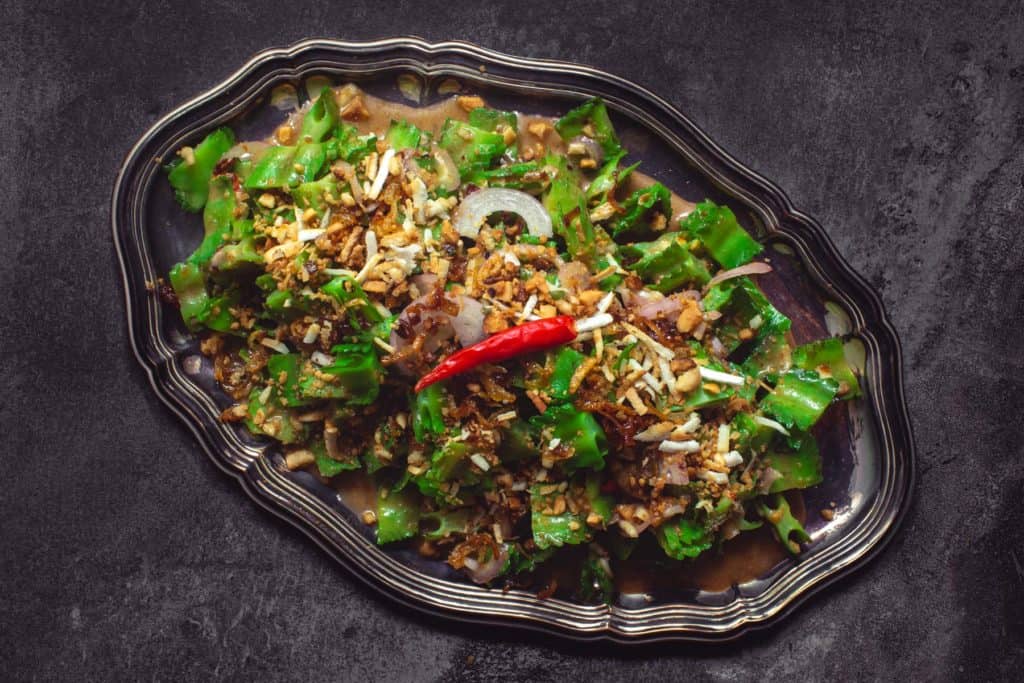Whether it's specifically a Thai winged bean salad or another yam (the Thai word for a loosely characterised salad) featuring a different vegetable, the style of Thai dressing yam tua pu utilises is always a favourite among my supper club guests. At its most basic, a yam dressing includes lime juice, sugar, fish/soy sauce, and chillies. The addition of nam prik pao and coconut cream adds richness and complexity.

What are winged beans
Psophocarpus tetragonolobus, a perennial climber plant, goes by many names depending on location. In Thailand, the name is tua pu, but in English we know it as winged (or wing) bean, Goa bean, asparagus bean, four cornered bean, Manila bean, and princess bean (among others, I'm sure). The entire plant is edible, including the pods, seeds, flowers, leaves, and root tubers.
Winged beans feature four ruffled fins and have a slightly waxy exterior. For me, wing beans sit somewhere on the flavour spectrum between peas, mange tout, and asparagus (though far less distinct than the latter). Author Kay Plunkett-Hogge, in her book Baan: Recipes and stories from my Thai home, suggests using asparagus as a stand in for tua pu if you cannot find winged beans (I am 100% in support of this suggestion).
In Thailand, the beans are consumed as young pods, eaten raw or blanched, as crudités or an ingredient in a cooked dish. Winged beans are a great accompaniment to nam prik, relishes for dipping and/or with rice. Sliced, they can be used in salads (like in this Thai winged bean salad recipe), in curries, stir fries, or even in tod man (deep fried curried fish cakes, easily made vegan).
📖 Recipe
Thai winged bean salad (yum tua pu – ยำถั่วพู)
Ingredients
- 125 grams winged beans cut into approximate 1 centimetre slices
- 1 litre water
- 2 teaspoons salt
- 1 ½ tablespoons thinly sliced shallot
- 1-2 bird’s eye chillies thinly sliced
- 3 tablespoons fresh or frozen grated coconut
- 3 tablespoons coconut cream see notes1
- 1 tablespoon thin soy sauce see notes2
- 1 tablespoon Thai chilli jam/paste (nam prik pao) see notes3
- 2 teaspoons fresh lime juice
- 1 teaspoon soft palm sugar see notes4
- 2 tablespoons ground roasted peanut
- 2 tablespoons fried shallot see notes5
Instructions
- Add the water and salt to a saucepan. Bring to the boil. When boiling, add the winged beans and cook for one minute. Strain under cold water and tip them into a small bowl. Add the sliced chillies and sliced fresh shallot to the same bowl.
- Heat a small pan to medium low heat. Add the coconut and cook, stirring constantly, until it dries and colours to a toasted light brown (a few minutes).
- Combine the toasted coconut, coconut cream, soy sauce, nam prik pao, lime juice, and palm sugar in a small bowl. Use a fork to mash the palm sugar and nam prik pao so the sauce is uniformly combined.
- Pour the sauce over the winged beans and mix so everything is coated.
- Serve the salad topped with roasted peanut and fried shallot.
Notes
- You do not need to buy anything specifically labeled as coconut cream. Buy a fatty coconut milk and use the thicker part of the liquid on top.
- There are many styles of soy sauce. While you can use whatever you have to hand, I recommend a Thai brand of thin soy sauce. Check out my guide to Thai soy and seasoning sauces for more info.
- Thai chilli paste, otherwise known as nam prik pao, takes a bit of time to make but it will be your favourite condiment.
- If the palm sugar you have is solid, you can pop it in a microwave to soften first.
- You can buy crispy fried shallots, but they pale in comparison to homemade fried shallots.
Transliteration note:
The word ยำ in Thai can be transliterated as "yam" or "yum," so when you see either of these words it has the same meaning (to toss/mix together).